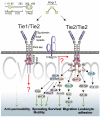Signaling and functions of angiopoietin-1 in vascular protection
- PMID: 16645151
- PMCID: PMC2270395
- DOI: 10.1161/01.RES.0000218275.54089.12
Signaling and functions of angiopoietin-1 in vascular protection
Abstract
Angiopoietin-1 (Ang1) has powerful vascular protective effects: suppressing plasma leakage, inhibiting vascular inflammation, and preventing endothelial death. Preclinical studies indicate that Ang1 may be therapeutically useful in a number of situations, including treatment of edema, endotoxemia, and transplant arteriosclerosis. However, the ligand has also been implicated in vessel remodeling, induction of angiogenesis and pulmonary hypertension, indicating that strategies to minimize any deleterious effects while optimizing vessel protection are likely to be needed. This review surveys the published data on vascular protective effects of Ang1 and highlights the therapeutic potential of this ligand, as well as possible limitations to its use. We also consider the data on Ang1 receptors and speculate on how to maximize therapeutic benefit by targeting the Tie receptors.
Figures

References
-
- Suri C, Jones PF, Patan S, Bartunkova S, Maisonpierre PC, Davis S, Sato TN, Yancopoulos GD. Requisite role of angiopoietin-1, a ligand for the TIE2 receptor, during embryonic angiogenesis. Cell. 1996;87:1171–80. - PubMed
-
- Dumont D, Gradwohl G, Fong G, Puri M, Gertsenstein M, Auerbach A, Breitman M. Dominant-negative and targeted null mutations in the endothelial receptor tyrosine kinase, tek, reveal a critical role in vasculogenesis of the embryo. Genes Dev. 1994;8:1897–1909. - PubMed
-
- Sato T, Tozawa Y, Deutsch U, Wolburg-Bucholz K, Fujiwara Y, Gendron-Maguire M, Gridley T, Wolburg H, Risau W, Qin Y. Distinct roles of the receptor tyrosine kinases Tie-1 and Tie-2 in blood vessel formation. Nature. 1995;376:70–74. - PubMed
-
- Patan S. TIE1 and TIE2 receptor tyrosine kinases inversely regulate embryonic angiogenesis by the mechanism of intussusceptive microvascular growth. Microvasc Res. 1998;56:1–21. - PubMed
-
- Puri MC, Partanen J, Rossant J, Bernstein A. Interaction of the TEK and TIE receptor tyrosine kinases during cardiovascular development. Development. 1999;126:4569–80. - PubMed
Publication types
MeSH terms
Substances
Grants and funding
LinkOut - more resources
Full Text Sources
Other Literature Sources
Molecular Biology Databases
Miscellaneous

